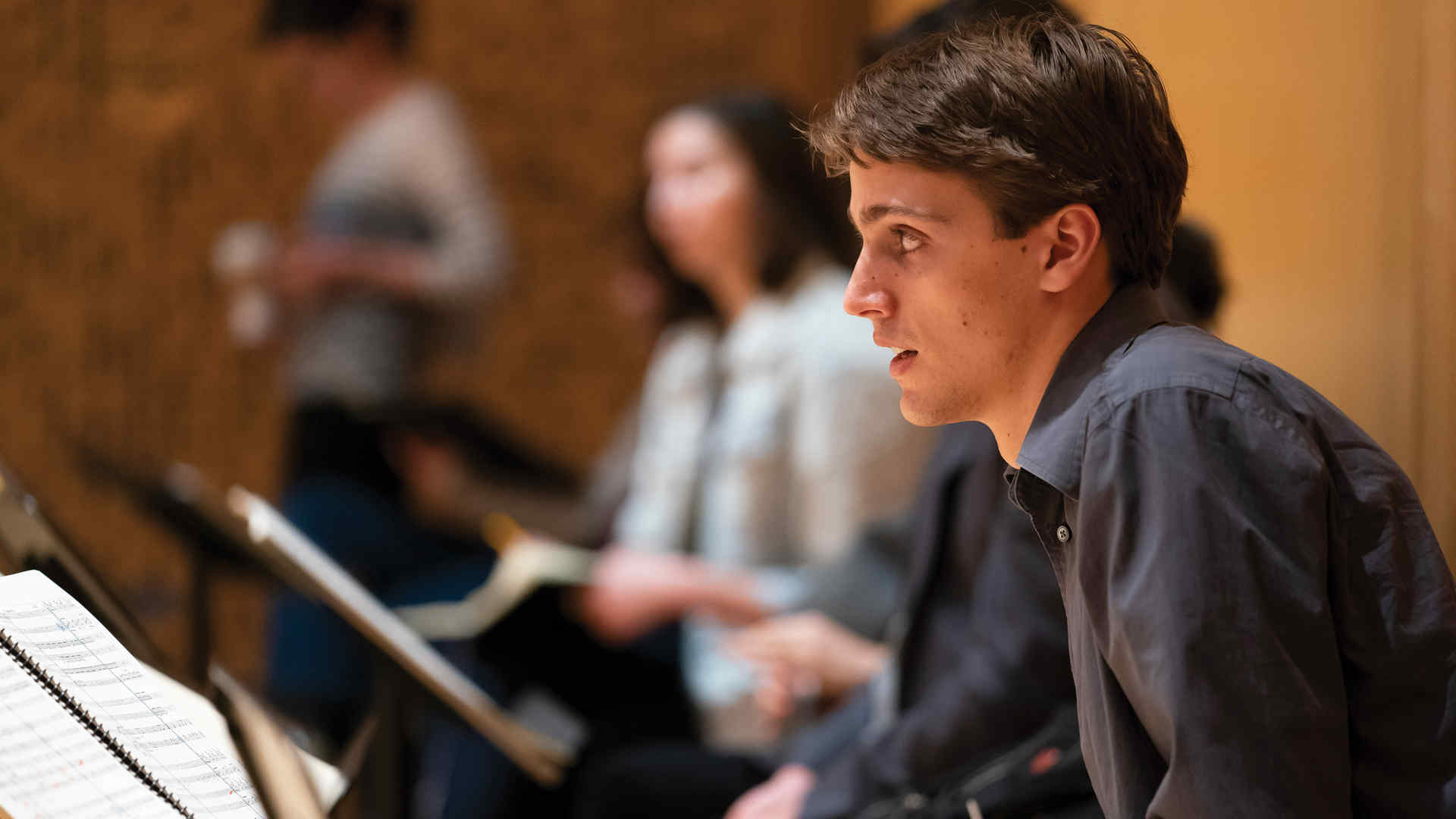
What do conducting students do all day? Quite a bit, it turns out. First-year master’s conducting student Sasha Scolnik-Brower recently chronicled a December day as he dashed from tutoring in Harlem to working as a cover conductor, and all sorts of other points along the way.
At 8am, I arrive with coffee in hand at a school in Harlem, where I spend 40 minutes tutoring the sweetest second grader you’ve ever met as part of a citywide volunteer program called Reading Partners. Today’s lesson is on words that end in “-ed”—my student is quick to pick it up, although it becomes clear that words like “batted” and “ended” are more difficult than “walked” and “talked” for him.
My coffee now lukewarm, I make my way to Alice Tully Hall by 9:15am and bring my scores and a stand out into the audience to await the start of the dress rehearsal for tonight’s Juilliard Orchestra concert, which will be conducted by faculty member Itzhak Perlman (Pre-College ’63; ’68, violin). This week I’m the cover conductor, which essentially means I attend all the rehearsals, listen for balance, take notes on questions from members of the orchestra, and, if needed, step in to conduct. This dress rehearsal is the only time to check balance for the Dvořák Cello Concerto in the hall, so it has to be efficient. As a cellist myself, I am particularly excited to be helping with the process from the conducting side of things.
As Mr. Perlman and Zlatomir [Fung, the soloist] work through the piece, I scribble down passages where I can’t hear the cello, where the brass is too heavy, or where the strings could play more. I walk up to the stage after they finish each movement to give them the problematic spots and then jog back into the audience as they try again. I give a big thumbs-up as the cello comes through beautifully in the second theme.
This week I’m the cover conductor, which means I attend rehearsals, listen for balance, take notes on questions, and, if needed, step in to conduct.
With my free half hour, I run out to find lunch that is not absurdly expensive, walking uptown a few blocks to grab a sandwich (it’s not very good). I get back to school around 1:15pm, in time to look over the scores before our conducting lesson. This week John Adams is working with us on two of his own pieces: The Wound Dresser, a beautiful setting of a Walt Whitman poem for baritone and chamber orchestra, and Chairman Dances, which Adams describes as “a set of outtakes” from his opera Nixon in China.
Our small conducting studio, Room 555, is quite full this week, with the three student conductors (myself, Kyle Ritenauer, and Elinor Rufeizen); our wonderful pianist, Art Williford; Dominik Belavy and Gregory Feldmann, the two student baritones who will perform in the concert; and Mr. Adams all packed in. Kyle, Elinor, and I each conduct part of both pieces, and Mr. Adams stops us every once in a while to make comments. Sometimes it’s to say that our tempo is not quite right, other times it’s to say, “I’m pretty sure you are following the pianist, not the other way around”—a critical but common mistake for conductors. These lessons are a chance for us to explore the music that we will be conducting the following day with the Lab Orchestra. Sometimes the sessions are analytical discussions; other times they are a chance to explore how we will physically express the music. Today, I make particular note of when Mr. Adams asks the baritone to sing in plainspoken American English rather than more formal diction.
We finish and I walk quickly down the hall to my Advanced Counterpoint class, acutely aware of the fact that, because our lessons can be quite long, I’m usually considerably late. I enter and Professor Lasser gives me a kind, curt nod as I take my seat. He is in the middle of making an impassioned case for the form of the last movement of Beethoven’s Ninth Symphony. I’m pretty convinced, and thankful to have something to refer back to when I study the piece later as a conductor. After class, I walk up a few blocks to meet my girlfriend who has just finished work—we head to a Thai restaurant not far from Juilliard to grab a quick bite.
Finally, at 7:15pm I arrive back at Alice Tully to watch the Juilliard Orchestra concert. It’s thrilling to be able to witness the final product of a long rehearsal process. I’m slightly nervous as Mr. Perlman and Zlatomir come on stage, wondering whether I somehow missed a spot where the cello is covered completely by the orchestra. But all goes well—the orchestra plays expressively and transparently with the soloist, and the acoustics are further aided by a full audience. After the concert, I work my way backstage to congratulate Mr. Perlman and the musicians before hopping on the 1 train to go home and start prepping for our Lab Orchestra session with John Adams at 10:15 the next morning.
Sasha Scolnik-Brower is a first-year master’s conducting student